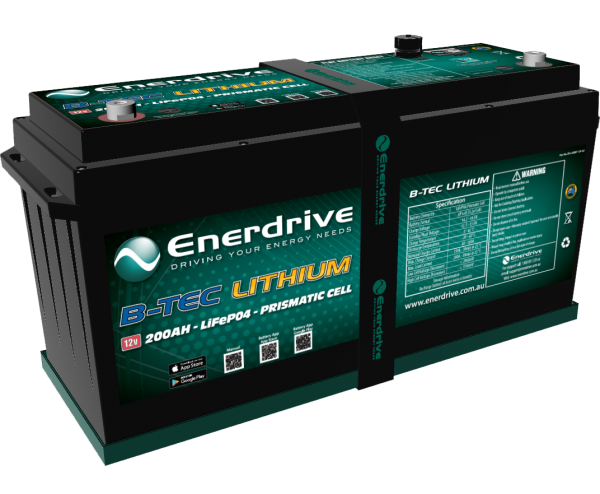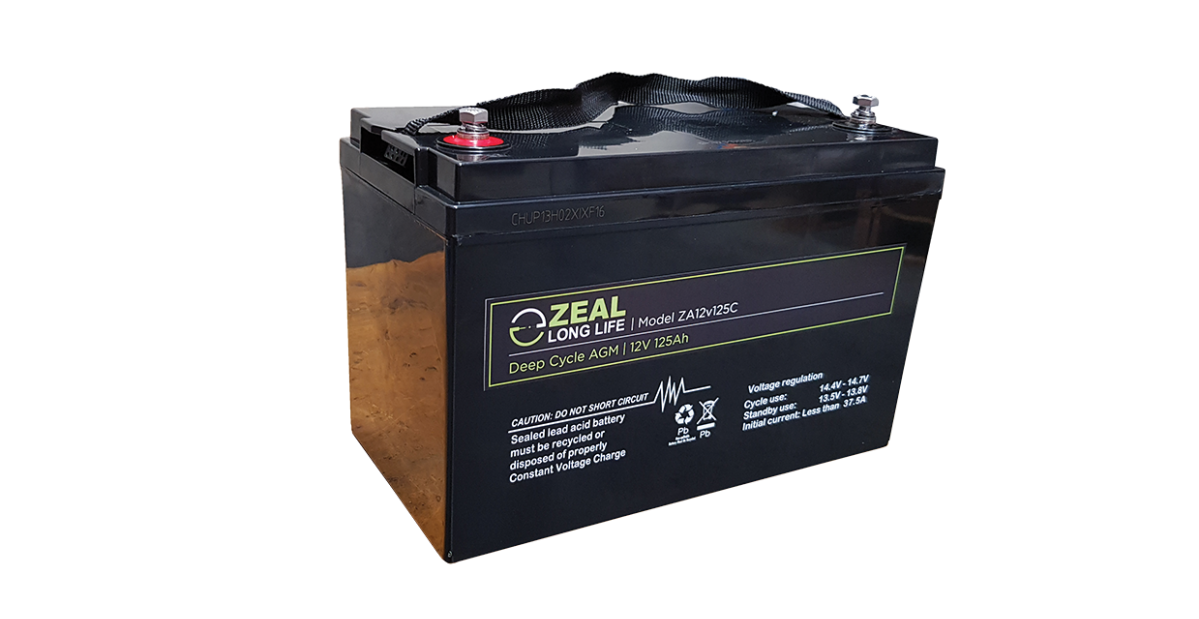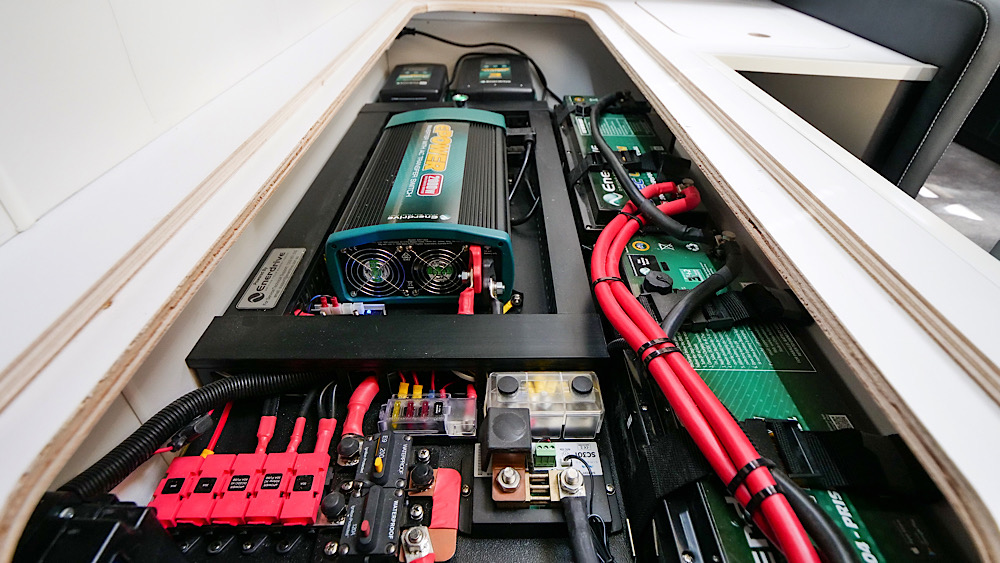Choosing the right caravan battery type is crucial as it determines the performance, lifespan, and efficiency of your power system. In this guide, we’ll explore the key differences between lead-acid and lithium batteries, their advantages and disadvantages, and how to select the best option for your caravan setup.
When travelling through the vast and remote landscapes of Australia, a reliable caravan battery is essential. Power failures in the outback can pose serious risks to safety and comfort, leaving you without lighting, refrigeration, or the ability to charge essential devices. Whether you're camping off-grid or staying at powered sites, choosing the right battery is crucial for an uninterrupted and enjoyable experience.
Caravan battery technology has evolved significantly over the years, with a notable shift from traditional lead-acid batteries to more efficient and durable lithium options. While lead-acid batteries, including AGM and gel varieties, remain popular due to their affordability and reliability, lithium batteries are now dominating the market. Their lightweight design, longer lifespan, and superior performance make them an attractive choice for modern caravanners. Understanding the differences between these battery types will help you make an informed decision based on your energy needs and travel style.
Let’s Start with Explaining the Types of Batteries
The most common type of battery used for caravan, camping, marine and automotive would be lead-acid. Why, you may ask? This is due to the high level of reliability coupled with lower associated expenses when compared to other types of batteries. There are 2 main types of lead-acid batteries:
-
Starting & Cranking batteries which offer quick, powerful short bursts of energy on start-up.
-
Deep cycle batteries which provide slow and consistent usage over longer periods of time.
You may be wanting to know which charge type is better? This really comes down to the application as this will determine the life expectancy of your battery as well as the performance you can come to expect. Generally speaking, a starting or cranking battery is used for automotive use, whilst caravanners, campers and mariners will use a deep cycle lead-acid battery.
.png)
Lead Acid Battery Construction:
The battery's construction is what greatly differentiates a starting/cranking battery to a deep cycle battery.
Starting/Cranking Batteries:
A starting/cranking battery has thinner lead plates inside which help provide a greater surface area of contact between the lead and acid resulting in a reaction that provides more power output and faster recharge times making them ideal for starting or cranking engines. Generally, these types of batteries are used for cars, generators, engines that require short bursts of energy upon start-up. The high output current can be measured by cold cranking amps (CCA). These batteries are designed to be continually recharged, thus holding the maximum capacity charge possible (this is usually between 90%-100% charge). The CCA is more important than Amp hours as it will tell you how much power is in the punch so to speak. High CCA batteries are not used for running appliances while in your caravan. For that application, we focus on deep cycle batteries that come in lead acid (AGM, Gel & Lithium).
Whilst the above is true for lead acid batteries. Deep Cycle Systems (DCS) range of lithium batteries have the ability to start engines. Each battery features Lithium Cranking Amps (LCA) ranging from 300 to 1300.
Deep Cycle Batteries:
A deep cycle battery has thicker lead plates resulting in less surface area contact between the lead and acid which is designed to slowly discharge and recharge making it ideal for running appliances such as fridges and lights while camping.
A deep cycle battery refers to the charge and discharge cycle of the battery. Thus, the more you drain/discharge your battery, the deeper the cycle. This is measured in Amp hours (Ah). Designed to be discharged at a low and consistent amperage over a long period. It is recommended that a deep cycle battery be recharged, above or before reaching 50% battery capacity in order for a longer life. These batteries are available in wet cell, gel and AGM battery varieties.
Battery Types Compared
|
Battery Types |
Cost |
Maintenance Required |
Engine Bay Mounting |
Weight |
Vehicle Application |
|
Lead |
Low |
Yes |
Yes |
Heavy |
Start/aux |
|
Calcium |
Low |
No |
Yes |
Heavy |
Start/aux |
|
AGM/Gel |
Medium |
No |
No |
Heavy |
AGM- Start/aux Gel- Start AGM |
|
Lead Crystal |
Medium |
No |
Yes |
Heavy |
Aux |
|
Lithium |
High |
No |
No |
Light |
Aux |
Types of Deep Cycle Batteries:
As we have just discussed, both deep cycle and starting/cranking batteries can be categorised into 3 varieties. These are:
-
Lithium
-
AGM (Absorbed Glass Matt)
-
Gel Cell
Choose a battery that matches your specific application to maximise its lifespan and ensure optimal performance in your caravan. Let’s discuss the differences in the types of lead-acid batteries.
Lithium Iron Phosphate (LiFePO4) Batteries
Lithium Iron Phosphate (LiFePO4) batteries have revolutionised the caravan battery market due to their superior performance characteristics. These batteries are significantly lighter than lead-acid counterparts, have an extended cycle life (often exceeding 2,000 cycles), and maintain high efficiency in energy transfer. They can also sustain deep discharges without significantly impacting their longevity, making them an excellent choice for off-grid caravan setups.
One of the key advantages of LiFePO4 batteries is their built-in Battery Management System (BMS), which monitors and protects against overcharging, over-discharging, and overheating. Additionally, LiFePO4 batteries are thermally stable and highly resistant to fire, making them a safer alternative compared to traditional lithium-ion chemistries.
AGM Batteries
Absorbent Glass Mat (AGM) batteries are a type of lead-acid battery where the electrolyte is absorbed in a fiberglass mat, reducing the risk of leakage. These batteries are known for their durability, maintenance-free operation, and budget-friendly pricing, making them a popular choice for caravanners who need reliable power without the higher cost of lithium batteries.
AGM batteries are particularly well-suited for rough terrains, as they are more resistant to shocks and vibrations than traditional flooded lead-acid batteries. This makes them an excellent option for off-road caravanning and situations where battery stability is essential.
Gel Batteries
Gel batteries use a silica-based electrolyte that transforms into a gel-like consistency, reducing the chances of leakage and evaporation. These batteries are highly resistant to high temperatures and deep discharges, making them ideal for hot climates and applications where consistent deep cycling is required. While they offer excellent longevity and safety, they are generally more expensive than AGM batteries and require specific charging profiles to avoid damage.
Lithium vs AGM vs Gel
Choosing between lithium, AGM, and gel batteries involves considering multiple factors, including cost, performance in extreme conditions, and weight efficiency.
Cost Over Time
While lithium batteries have a higher upfront cost, they offer significant savings over time due to their extended lifespan and reduced need for replacements. AGM and gel batteries, though cheaper initially, typically have a lifespan of 3–5 years, whereas lithium batteries can last 10 years or more with proper maintenance. Additionally, lithium batteries maintain their performance levels longer, whereas lead-acid alternatives experience gradual capacity loss over repeated charge cycles.
-
Lithium: Higher initial investment but lower cost per cycle over time.
-
AGM: Affordable upfront but requires more frequent replacements.
-
Gel: Expensive compared to AGM but offers slightly longer life in high-heat applications.
Performance in Extreme Conditions
Different battery chemistries perform better in varying environmental conditions.
-
Heat Tolerance (Gel Batteries): Gel batteries perform exceptionally well in high-temperature environments. Their silica-based electrolyte prevents excessive evaporation and breakdown, making them a preferred choice in hotter climates.
-
Cold Performance (AGM Batteries): AGM batteries outperform both gel and lithium batteries in extreme cold. They maintain better charge retention and discharge efficiency in freezing conditions, making them ideal for alpine or winter camping.
-
Lithium Batteries: While lithium batteries generally handle a wide range of temperatures well, they require integrated heating solutions to operate efficiently in sub-zero temperatures.
Capacity vs Weight
Weight plays a crucial role in caravan and 4WD setups, particularly when optimising payload capacity.
-
Lithium Batteries: Offer the best energy density, meaning more usable amp hours in a smaller and lighter package. A 100Ah lithium battery is about half the weight of an equivalent AGM battery, making it the best option for weight-conscious travellers.
-
AGM Batteries: Heavier and bulkier than lithium alternatives but still a practical choice for those on a budget.
-
Gel Batteries: Similar in weight to AGM but slightly more efficient in terms of usable capacity.
For 4WD setups and off-road caravanning, lithium is often the preferred choice due to its lightweight properties and superior energy efficiency.
Choosing the Right Battery
Selecting the right caravan battery is essential for ensuring reliable power during your travels. The best choice depends on your energy needs, the type of adventures you embark on, and your budget.
Assessing Power Needs
Before investing in a caravan battery, you must determine how much power you require to run your essential appliances and devices. Factors to consider include:
-
Fridges – Portable fridges or built-in caravan fridges can be among the biggest power consumers. A typical 12V compressor fridge may use 30-60Ah per day, while a 3-way fridge running on battery power can drain your system rapidly.
-
Lights – Caravan lights consume minimal energy, usually between 1-5Ah per hour, but older halogen or incandescent lights use significantly more.
-
Inverters – If you plan to use 240V appliances (e.g., microwaves, coffee machines, or laptops), an inverter is required. The larger the inverter, the higher the battery drain.
Calculating Energy Consumption
A very basic guide to selecting your battery size would be to understand and work out your average amp draw from the appliances you plan to run using your battery and multiply this by the length of time in hours you require power. This will give you an approximate total Amp hours required from your battery. To calculate the average amp draw from your appliances, please refer to the product manual for manufacturers specifications.
For example: Say you have an appliance that has an average Amp draw of 5 Amps per hour. You want to run this setup for 20 hours without the use of a charger. (20 hours X 5 Amps per hour = 100AH) You would theoretically need a 100AH rated battery.
Of course there are many factors that will influence the ACTUAL Amp hour output of your battery that often results in less Amp hours than the manufacturers rating. It is best to over-estimate your battery requirements by at least 20- 50% as an absolute minimum.
Best Caravan Battery Brands Compared
|
Brand |
Best For |
Battery Types |
Key Features |
|
Premium lithium choice |
LiFePO4 (Lithium) |
High discharge rates, built-in BMS, Australian-designed |
|
|
Off-grid power users |
LiFePO4 (Lithium), AGM |
Smart Bluetooth monitoring, efficient charging |
|
|
Affordable lithium option |
LiFePO4 (Lithium), AGM |
Budget-friendly, good BMS, solar-ready |
|
|
Long-lasting lithium performance |
LiFePO4 (Lithium) |
Deep cycle durability, 7+ year lifespan |
Which One Should You Choose?
-
For the best lithium battery: Enerdrive or Victron Energy (high quality, smart BMS).
-
For a reliable AGM battery: Century Batteries or Power AGM (affordable & durable).
-
For 4WD/caravan dual battery setups: Enerdrive (high quality, best for DC-DC charging).
-
For budget lithium: Renogy (good value without premium pricing).
Compatibility Factors
When selecting a battery, you must ensure it is compatible with your caravan’s charging system and voltage requirements.
Most caravan systems run on 12V, but some larger setups use 24V or even 48V systems for heavy power use. Always match your battery voltage to your caravan’s electrical setup.
Charging Systems
-
Solar Panels – If you rely on solar power, ensure your battery is compatible with your solar controller and can efficiently store energy. Lithium batteries are ideal for solar setups due to their high charge efficiency.
-
Alternator Charging – Some caravan batteries can charge while driving through the vehicle’s alternator, but lithium batteries require a DC-DC charger to regulate voltage properly.
-
Mains Charging – If you stay at powered sites, a 240V charger with the correct profile for your battery type (AGM, gel, or lithium) is essential for longevity.
Installation
A well-planned installation prevents issues like voltage drops, overheating, or electrical failures. Below is a step-by-step guide to installing your caravan battery system.
1. Choose a Suitable Location
-
The battery should be secured in a ventilated, waterproof, and vibration-resistant area.
-
For AGM or gel batteries, ensure there’s enough airflow to prevent heat buildup.
-
Lithium batteries can be installed inside the van, as they don’t release harmful gases.
2. Connect the Battery to the Caravan's Electrical System
-
Use correct gauge wiring – Thicker cables reduce voltage drop, especially for longer runs.
-
Fuse protection – Install fuses or circuit breakers as close to the battery as possible to protect against short circuits.
-
Main isolator switch – Allows for quick battery disconnection in emergencies.
3. Wiring Diagrams & Safety Protocols
-
Parallel vs. Series Wiring – If using multiple batteries, decide between parallel (12V, more capacity) or series (higher voltage, 24V/48V).
-
Fuse placement – Use appropriately rated fuses between the battery and components (e.g., 50A-150A depending on your system).
-
Grounding – Proper earthing prevents electrical faults.
Tip: Always use heat-shrink connectors and cable lugs for secure connections, preventing loose or corroded terminals.
Solar Integration
If your caravan relies on solar power, correctly integrating your panels with your battery system is essential for maximum efficiency.
MPPT vs. PWM Solar Controllers
-
PWM (Pulse Width Modulation) Controllers
-
More affordable but less efficient (suitable for small AGM/Gel battery setups).
-
Works best when solar panel voltage closely matches battery voltage.
-
-
MPPT (Maximum Power Point Tracking) Controllers
-
Converts excess voltage into usable current, boosting solar efficiency by up to 30%.
-
Ideal for lithium batteries and larger solar arrays.
-
Sizing Your Solar Panels for Lithium Efficiency
-
Lithium batteries charge faster and more efficiently than AGM/Gel, meaning you need to optimize panel size.
-
Recommended solar input:
-
100Ah Lithium Battery → 200-300W Solar Panels
-
200Ah Lithium Battery → 400-600W Solar Panels
-
-
Solar Regulator Placement – Mount the controller close to the battery to minimize energy loss.
Tip: A tilt-adjustable solar panel mount can improve charging efficiency by up to 40% compared to flat-mounted panels.
Dual Battery Systems
A dual battery system allows you to run caravan appliances without draining your vehicle’s starter battery. These setups are crucial for off-grid travel and 4WD touring.
Key Components of a Dual Battery System
Battery Isolators
-
Basic solenoid isolators disconnect the auxiliary battery when the engine is off to prevent drainage.
-
Suitable for AGM setups but not ideal for lithium due to inconsistent charge regulation.
DC-DC Chargers
-
Regulates voltage from the alternator to ensure proper charging.
-
Necessary for lithium batteries, as alternators alone cannot fully charge them.
-
Some models have built-in MPPT solar regulators, allowing dual charging from solar + alternator.
Protecting the Starter Battery
-
Always install a low-voltage disconnect (LVD) to prevent deep discharge.
-
A monitoring system (e.g., battery management system or BMS) helps track charge levels and prevent overcharging.
Tip: A 120Ah lithium battery with a DC-DC charger can provide power for an entire weekend without running your vehicle.
Maintenance & Care
Proper battery maintenance ensures longer lifespan, better efficiency, and reliable performance on your travels. Whether you have an AGM, Gel, or Lithium battery, following these care guidelines will prevent common issues and costly replacements.
Routine Checks
Regular inspections and minor upkeep can prevent failures and extend battery life.
Cleaning Terminals & Connections
Over time, battery terminals can corrode, leading to poor conductivity and voltage drops.
How to clean terminals:
-
Disconnect the battery.
-
Use a baking soda + water solution to neutralize corrosion.
-
Scrub terminals with a wire brush and apply petroleum jelly or terminal protector spray to prevent future buildup.
Monitoring Voltage & Charge Levels
Keeping an eye on your battery’s voltage helps you prevent deep discharges and identify early signs of failure.
Voltage Guide for 12V Batteries
-
12.7V - 13.2V → Fully charged
-
12.2V - 12.4V → 50% charged (Recharge ASAP)
-
Below 12.0V → Critically low, may cause permanent damage
-
Over 14.6V while charging → Overcharging risk (Check regulator settings)
Tip: Use a battery monitor with Bluetooth to track voltage in real-time from your phone.
Avoiding Deep Discharges
-
AGM/Gel batteries should never drop below 50% charge, or their lifespan will reduce significantly.
-
Lithium batteries can handle 80-90% discharge, but excessive cycles can still reduce longevity.
-
Consider a low-voltage disconnect (LVD) to automatically shut off loads before damage occurs.
Seasonal Storage
If you’re not using your caravan for extended periods, proper storage is essential to keep your battery in good condition.
Ideal Charge Levels for Storage
-
AGM/Gel batteries → Store at 100% charge, then check every 2-3 months and top up if it drops below 12.6V.
-
Lithium batteries → Store at 40-60% charge for the longest lifespan (Avoid full charge or deep discharge).
Temperature-Controlled Storage Tips
-
Extreme temperatures can damage batteries or cause excessive self-discharge.
-
AGM/Gel: Store in a cool, dry place; avoid below freezing temperatures.
-
Lithium: Store between 5°C - 25°C; avoid below 0°C or above 40°C for extended periods.
-
If storing in the caravan, disconnect the battery from all loads to prevent slow discharge.
Tip: If using solar panels, install a solar charge controller with a float mode to maintain batteries during storage.
Troubleshooting Common Issues
If your battery isn’t performing as expected, these common problems may be the cause:
Voltage Drops & Slow Charging
Possible causes:
-
Loose or corroded terminals → Clean and tighten connections.
-
Thin wiring → Upgrade to thicker cables to reduce voltage drop.
-
Faulty charger → Test with a multimeter to ensure correct output.
Sulfation in AGM & Gel Batteries
What is sulfation?
-
A condition where lead sulfate crystals form on plates, reducing capacity.
Symptoms:
-
Battery struggles to hold charge.
-
Voltage stays low even after charging.
Solution:
-
Use a desulfating charger (smart charger with reconditioning mode).
-
Avoid prolonged storage in a discharged state.
Lithium Battery BMS Errors
Lithium batteries have a Battery Management System (BMS) to protect against:
-
Overcharging – BMS shuts down to prevent overheating.
-
Over-discharge – BMS disconnects output when the battery is too low.
-
Overcurrent/Short Circuit – Automatic shutdown to prevent damage.
Fixing a BMS Lockout:
If the battery won’t charge or output power, try resetting the BMS:
-
Disconnect the battery completely for 5-10 minutes.
-
Reconnect and attempt to charge using a low-current charger (e.g., 5A-10A).
-
If still unresponsive, check manufacturer instructions for a hard reset.
Tip: Investing in a battery monitor with a built-in BMS display can help diagnose errors before they become major issues.
Compliance Standards
Caravan battery installations in Australia must meet electrical safety standards to ensure reliability and prevent hazards like fire, electrocution, or battery failure.
Electrical Installations in Caravans
The AS/NZS 3001:2025 standard outlines the legal requirements for 12V and 240V caravan electrical systems. Key rules include:
Battery Installations:
-
Batteries must be secured and ventilated to prevent overheating.
-
Lithium batteries must not be installed in engine bays due to heat risks.
-
Cables should be properly insulated and secured to prevent wear.
Fusing and Circuit Protection:
-
All battery circuits must include a fuse or circuit breaker close to the battery.
-
240V inverters require residual current devices (RCDs) for shock protection.
Solar & Dual Battery Compliance:
-
MPPT charge controllers must be rated for the correct voltage and current.
-
DC-DC chargers must comply with vehicle alternator voltage requirements.
Tip: If you're unsure about compliance, have a licensed auto-electrician inspect your setup.
Caravan Battery FAQs
Can I mix lithium and AGM batteries?
No, it's not recommended. Lithium and AGM have different charging voltages and discharge rates, which can cause uneven charging and reduce battery lifespan. If you need both, use separate chargers to manage them independently.
How do I revive a deeply discharged gel battery?
Try these steps:
- Use a low-amp manual charger (2A-10A) to slowly recharge.
- Connect a fully charged AGM battery in parallel to help jump-start the gel battery.
- Use a smart charger with Recovery Mode (e.g., CTEK MXS 5.0) if available.
If the battery still won’t hold a charge, it may need replacing.
What’s the best battery for a caravan with a 3000W inverter?
A 3000W inverter needs a large battery bank:
- Best option: 400Ah+ Lithium (12V) or 200Ah+ (24V) for efficiency and long life.
- Budget option: 500Ah+ AGM (12V), but it's heavier and has a shorter lifespan.
- If using 24V, the inverter draws half the current, improving efficiency.
What caravan battery would best suit your caravan setup? Choosing the best caravan battery in Australia depends on your power needs, budget, and travel style. Whether you opt for lithium or AGM caravan batteries, understanding their differences is key—lithium offers superior lifespan and efficiency, while AGM remains a reliable, budget-friendly choice. Investing in high-quality deep cycle batteries for caravans ensures consistent power for fridges, lighting, and appliances, especially when travelling off-grid. For those seeking off-grid caravan power solutions, combining the right battery with solar panels and smart charging systems will provide a seamless, self-sufficient energy setup. With the right knowledge and equipment, you can power your adventures with confidence!
-
DISCLAIMER* Please note, this advice is general in nature and we strongly recommend consulting the product manual and where relevant, a professional installer.
Comments (2)
Mention chargers needed for different types
Eg, will a charger designed to charge an AGM battery still charge a LithiumBy: Terence Richard Roos on 20 December 2022
www.caravanrvcamping.com.au Response
You are best to contact the supplier of your AGM charger to check on its compatibility with lithium. Alternatively you can call us on 1800 787 278 and we can check it out for you









